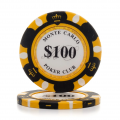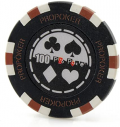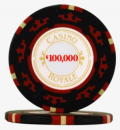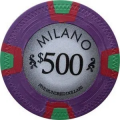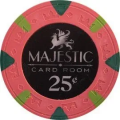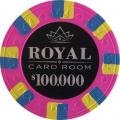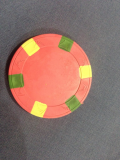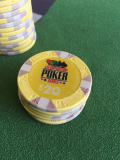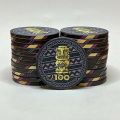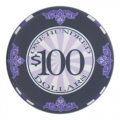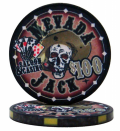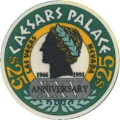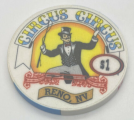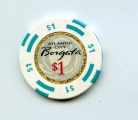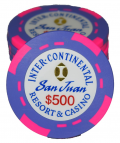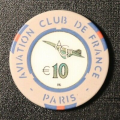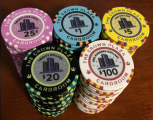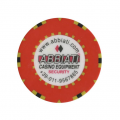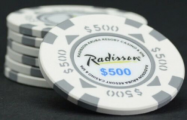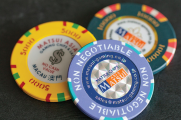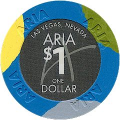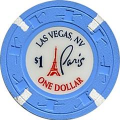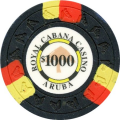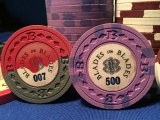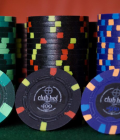Welcome to the forum! You're asking all the right questions. Sadly, no, there is not one place to look to find all the answers; new members have had to slowly put the pieces together by reading and searching the archives. But since you've asked, I'll take a stab at making a good starting place right here.
This is going to be a big post, spread across several posts, and it'll take me a while to get them all put up. Please be patient.
Also, while I'll try to cover the big picture, there's going to be a lot of details I won't get into, which means that this will necessarily be incomplete and inaccurate in a lot of ways, but hopefully all of those omissions and inaccuracies will be small and not particularly important to a new member such as yourself.
---
The first thing you should know is that poker chips can be usefully divided into five broad categories, and that these categories roughly correspond to both quality and price, in increasing order:
- Mass-market plastic chips
- Enthusiast-grade plastic chips
- Ceramics
- Casino-grade plastic chips
- Casino clays
Mass-Market Plastics
Mass-market plastic chips are readily available at retail outlets such as
Amazon and Walmart. Most of them contain a metal insert (a "slug") to add weight. Nowadays they come in a wide variety of graphic designs, but in the earlier days the most common design was a generic pattern: six stripes with spotted dice between the stripes; we now call these "dice chips".
View attachment 765139
Here's a small selection of other designs:
View attachment 765141View attachment 765143View attachment 765144View attachment 765145
Regardless of design, these all have a few things in common: they're made from injection-molded plastic, they contain a metal slug for added weight, and the graphic design in the center of the chip is printed on an adhesive decal (basically, a sticker).
Very often these chips will be marketed with phrases such as
clay,
clay composite, and
official casino weight. The terms clay and clay composite mean nothing in this case; these chips are made out of plastic and are completely unlike the clay chips used in casinos. There's no such thing as an official casino weight; casinos use a variety of chips with a wide range of weights. Slugged mass-market plastic chips weigh between 11.5 and 14 grams, whereas casino clays weigh between 8 and 11 grams. Casinos also use ceramic chips and plastic chips, and the plastic chips casinos use have the same range of weights as the mass-market plastic chips, although the casino grade plastics are a much higher quality.
Mass-market chips like these are considered the lowest quality by chip enthusiasts. They're heavier than the clay chips most prefer. Very often, the plastic they're made from is very slick, which makes the chips difficult to handle and stack. Even so, some of these types of chips are more highly regarded than others and can make a good choice for someone on a tight budget. Notable brand names include Outlaw, Monte Carlo, Showdown, Casino Royale, Desert Heat, and The Mint, but there are others as well.
Enthusiast Grade Plastics aka China Clays
Enthusiast-grade plastic chips are made for and marketed to people who are looking for a high-quality chip at affordable prices. Like the mass-market chips, they are made out of injection-molded plastic and use a decal for their graphic designs; however, they do not contain a metal slug. Their graphic design and the plastic they are made from are designed to imitate the look and feel of casino clays as closely as possible. Since these are made in China (whereas casino clays are made in the US and Mexico), they've come to be known as "China clays".
Notable china clay brand names include Milano, Majestic, Royal, The Bank, Dunes, and Pharaohs (these last two are china clay tributes to the original versions which were casino clays, which can sometimes be confusing). Older china clay brand names that are no longer widely available include Spirit Molds and Championship Poker Series.
Here are a few examples:
View attachment 765164View attachment 765165View attachment 765166View attachment 765168View attachment 765169
China clays can be found at various poker chip retailers online, most notably
Apache Poker Chips. Some brands may be available on
Amazon or
eBay, but in general you won't find china clays at major retail outlets. They're a good choice for someone who wants something more like casino clay chips than the mass-market chips are, but is on a somewhat limited budget.
Ceramics
Ceramic chips are widely used both in casinos as and in home games. They're readily available, come in an endless variety of colorful and distinctive graphic designs, can be easily customized, and are very affordable compared to casino clays. Despite the name, ceramics aren't made out of ceramic; they're injection-molded plastic. The particular blend of plastics used makes them
feel somewhat like ceramic.
The distinctive feature of ceramic chips is that they can be printed on using a method called dye-sublimation (aka "dye-sub"). All the other types of chips covered here have their graphic designs printed on circles of paper or plastic which are then either glued to or pressed into the surface of chip. Ceramics have their graphic designs printed directly
onto the chip surface. The dye-sub process actually slightly evaporates the ink and the chip plastic so that the printed design is bonded
into the chip surface, which makes the printed design very durable and resistant to wear. It also means that the graphic design covers the entire face of the chip and the rolling edge; other types of chips have the graphic design only in the center of the chip, with the other elements (such as colored spots and debossed mold impressions) being molded into the chip body.
There are a few ceramic brands that are available through mass-market outlets: Nile, Scroll, and Laurel Crown. Those aren't very well-regarded, though. Higher quality ceramics can be obtained from vendors such as
ABC Gifts and Awards and
Sun-Fly. Both of those vendors have a number of stock designs available, including frequent favorites Dia De Los Muertos and Tiki Kings. The chief appeal of ceramics, though, is that they are completely customizable; ceramic chip vendors can print chips using any graphic design you like. You can get custom ceramics from ABC, Sun-Fly, or via certain Chinese vendors that many of our PCF members have been working with (these are often called the "cards mold" vendors). There are other sources you can buy various ceramic stock designs or customs from as well; you can find them with a google search.
This earlier post of mine, as well as the rest of that thread, discusses ceramic chips in more detail.
Here are a few examples, including some from actual casinos:
View attachment 765195View attachment 765198View attachment 765208View attachment 765214View attachment 765215
[TO BE CONTINUED]



